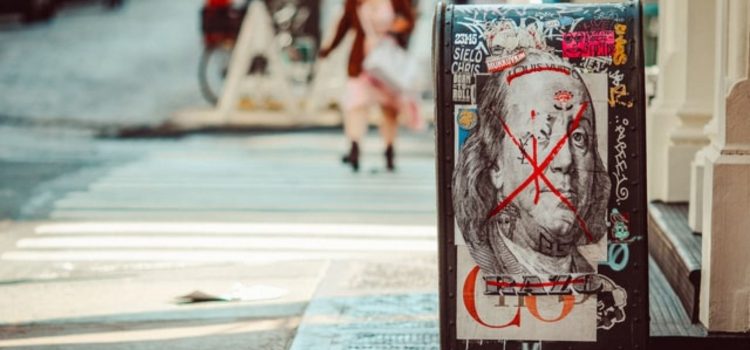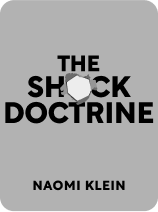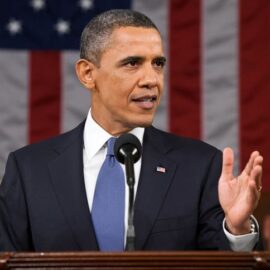

This article is an excerpt from the Shortform book guide to "The Shock Doctrine" by Naomi Klein. Shortform has the world's best summaries and analyses of books you should be reading.
Like this article? Sign up for a free trial here .
What is disaster capitalism? What is the connection between violence and capitalism?
According to Naomi Klein, disaster capitalism can’t exist without widespread state violence. At the same time, those two things are largely disconnected in people’s minds. The reason for this is that free-market economists did all they could to separate their theories from the cruel methods used to implement them.
In this article, Klein explains the role of violence and repression in instituting free-market capitalism.
The Free Market and Political Terror
According to Naomi Klein, disaster capitalism can’t be instituted without mass violence. Disaster capitalists believed that the market had to be absolutely free of what they called distortions, such as social programs and government regulations.
This emphasis on purity naturally meant that a regime trying to implement these theories couldn’t tolerate the existence of competing ideologies, like developmentalism. Anything that threatened to cause “distortions” in the market had to be wiped out by any means necessary.
This is exactly what disaster capitalists did in Southern Corn using a combination of propaganda, terror, and brute force. Books about socialism and social issues were burned en masse. Leftists from all walks of life, from politicians to students to soup kitchen volunteers, were arrested and tortured or killed. Trade union leaders were some of the juntas’ favorite targets—and attacks on union leaders were often carried out with the approval, and sometimes the direct involvement, of the companies they worked for.
At the same time as all of these attacks and kidnappings, the juntas spread propaganda about the dangers of socialism, Marxism, leftism, or any -ism that opposed their fundamentalist ideals of pure profit. Governments encouraged their citizens to report anyone harboring such “dangerous” ideas, whom they termed foreign extremists or radicalized nationals. Doing so helped cement the idea of “Us versus Them” in the minds of many of their supporters.
Torture as Treatment
The juntas performed all of these horrors in the name of curing the “disease” of socialism. They tried to cast themselves not as violent criminals, but as doctors and healers—much like the Nazis had done before them, the juntas claimed that by killing off “sick” people they were making society as a whole healthier.
Meanwhile, as the juntas’ policies tried to purge socialism from economies, their prisons tried to purge it from individuals. They did so with varied and horrific forms of torture. In theory, the torture was about gaining information, but the real goal was to break their prisoners.
The ultimate test of the prisoners’ conditioning was to get them to betray their closest friends. It often didn’t matter what people or information the victims gave up; the betrayal itself was the goal. Someone who was willing to sell out his closest friends and allies was someone who had given in to pure self-interest.
Those whom the camps successfully broke would adopt the same cutthroat ideology of pure self-interest that fueled the new economies. They would make “deals with the devil,” wherein they allowed other prisoners to suffer worse tortures so that they themselves would be spared. Sometimes they even administered the tortures themselves. Some went on TV to publicly renounce their old ideals and praise the new regimes.
Survivors of the torture camps described a system designed to shock them into compliance, often literally. They were expected to give up the very idea of solidarity, of helping others. For many Latin American leftists, that was the single most cherished value they had.
Disconnecting Violence From Capitalism
Naturally, Milton Friedman and his colleagues were all too happy to take credit for the economic “miracles” happening in Chile and elsewhere. However, they denied any connection between their economic theories and the brutal repression happening in those countries.
Friedman said that he disagreed strongly with the new totalitarian government of Chile, but nonetheless saw nothing wrong with offering economic advice to Pinochet’s government. He condemned the electric shock treatments happening in prisons, but still applauded the economic shock treatments happening to the countries.
Friedman received the 1976 Nobel Prize in Economics for his theories on the relationship between inflation and unemployment, and how to correct both. He used his Nobel address to make the case that economics was as scientific a field as chemistry or physics, and as such that economists needed to observe the facts impartially. His point was that people should look past the juntas’ horrific methods, and see that the free market worked. He claimed that Chile—the only country bold enough to properly implement his theories—was the proof.
Ironically, even as he touted the importance of impartiality and commitment to the facts, Friedman and his supporters ignored the fact that free-market policies had caused widespread unemployment, starvation, and sickness in the Southern Cone—things that were wholly separate from the juntas’ deliberate abuses of power.
Then, just one year after Friedman got his Nobel Prize in Economics, Amnesty International received the Nobel Peace Prize for its work to expose the human rights abuses in Chile and Argentina.
The Nobel Peace Prize is actually completely unrelated to the Nobel Prize in Economics; the two awards are given by entirely different committees, based in different cities. However, to an outside observer, it looked like one of the world’s most prestigious decision-making bodies had made a clear statement: The economic aspects of these new governments were separate from the torture and repression those governments inflicted. One was worthy of praise (hence Friedman’s award for pioneering free-market capitalism), and the other was worthy of condemnation (hence Amnesty International’s award for exposing the juntas’ actions).
Amnesty International’s Shortcomings
On top of the misleading image given by the two conflicting Nobel Prizes, the connection between state brutality and free-market capitalism was further muddied by the very nature of Amnesty International.
Amnesty’s mission statement said that it was to be totally independent and impartial; not beholden to any country, religion, political party, or economic system. That was an admirable goal on the surface, but it made Amnesty uniquely unqualified to expose the real reasons behind the juntas’ brutality.
Because it couldn’t show favor to one economic system or another, Amnesty’s report on the juntas’ reigns of terror were framed in terms of individual human rights abuses, rather than a coordinated effort to impose radical capitalism. Without that framework, the report showed a horrifying but disjointed jumble of sadistic acts. The extremes that the juntas went to seemed almost nonsensical—easy to condemn, but nearly impossible to understand.
This shortcoming was perhaps most noticeable in the report on Argentina. Amnesty International noted that the actions the Argentine government had taken were completely disproportionate to any threat posed by leftist insurgents, but made no attempt to explain why those actions had actually been taken. Additionally, their report on Argentina only discussed the conflicts between military forces and left-wing radicals—it completely omitted any involvement by the US government, international corporations, and even landowners in Argentina.
A Free Market Demands Violence
Each of these violent episodes shows that free-market capitalism can never, and will never be enforced without widespread violence and terror. It enriches a few by taking from many, and will therefore always be wildly unpopular. In order to survive, the free market needs to keep the common people obedient through force and fear.
The main flaw in all of the investigations and reports on the juntas is that they only reported on the kidnappings, tortures, and murders. They all presented the Southern Cone as if it were the site of a grisly murder, and went into great detail about the blood that was spilled and the lives that were destroyed. Based on those reports, one might get the impression that the juntas’ violence was indiscriminate and nonsensical; cruelty for its own sake.
However, it would be much more accurate to compare the Cone to the scene of a violent robbery. The capitalist extremists were taking away everything that people needed to live comfortably and with dignity. When the people refused to hand over their wealth, they “disappeared” or were simply shot dead in the street—and then the juntas took what they wanted anyway. The investigations failed to draw that connection from the free market to state violence, and that was their greatest failure.
As a result of that failure, even though the military dictatorships in those countries have long since lost their power, the ideology of the Chicago School is deeply rooted in the Southern Cone, and indeed the entire world. Friedman’s ideal of the free market—and the violence needed to implement it—keeps cropping up even in the present day; and, even in the present day, people see those two things as completely unrelated.

———End of Preview———
Like what you just read? Read the rest of the world's best book summary and analysis of Naomi Klein's "The Shock Doctrine" at Shortform .
Here's what you'll find in our full The Shock Doctrine summary :
- A study of the history of economic shock therapy
- How economic shock therapy gave rise to the disaster capitalism complex
- How communities are beginning to recover from the destructive shock treatments






